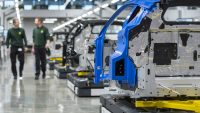A balloon for the kids, a box of Week-End chocolates for Mum, and maybe, just maybe, if he committed to the GLX model, a smart polyester tie for Dad.
These are the things that car dealers offered their customers to keep them coming back over the years, progressing from Austin Maxi to Maestro, Ford Sierra to Mondeo, Vauxhall Cavalier to Vectra.
Such a sales strategy, like the aforementioned gifts and the cars of yesteryear, belong in the museum now and even more contemporary techniques that were perfectly adequate at attracting and maintaining car customers just a few years ago are now equally antiquated.
Of course, a retailer could significantly boost its CRM budget and hand out LEGO Disney Frozen Ice Castles and Technic Lamborghini Sián FKP 37s, Grand Cru Chocolates by Pierre Marcolini, and iPad minis, but that will have little effect on customers who never step through a showroom door and choose to purchase their next car online instead.
Every innovative automotive retailer, whether they are selling used vehicles through a single site, or operating multiple new car franchises, recognises the importance of reaching its customers through both ‘bricks and clicks.’
They also know that adopting an omnichannel approach wasn’t just a helpful strategy to see them through the pandemic, but an essential pillar to delivering sustained growth and increased revenue in the future.
This knowledge is comprehensively backed up by new data released by the Automotive Transformation Group (ATG), which reveals that online sales enable automotive retailers to move stock 20 per cent faster than traditional methods.
Tim Smith, chief revenue officer at Automotive Transformation Group, now believes there is no going back.
He said: ‘Automotive retailers who have embraced e commerce are now reaping the rewards and will continue to do so in the coming years. The pandemic made buying cars online a reality for many, and now the genie is out of the bottle.
‘It’s just a case of how quickly and how well the industry adapts to this demand.
‘A successful ecommerce strategy is now proven beyond all doubt to be essential for attracting new customers, reducing costs, and ultimately moving stock faster and maximising profitability.’
However, retailers would be very wrong to assume that it is their old customers, the ones who used to walk through the door and that they knew by sight and name, who are solely providing the surge in online business.
ATG’s recent findings, based on data, collated in partnership with a leading UK multi-franchise auto retailer operating over 20 locations, also reveal that 80 per cent of ecommerce transactions were made by net new customers to the business.
Smith added: ‘This proves that ecommerce sales are unrestrained by geographical boundaries and that customers are happy to search for the car they want much further afield than their local retailer.
‘Studying over 80,000 transactions, our data shows that, today, the average delivery distance is 69 miles and that customers are willing to travel up to 55 miles to collect their new car.’
A robustly proven digital platform is essential to enable a business to engage with its customers online, but so too is the business’ ability to embrace the technology into its working practices and culture fully.
When it does that successfully, the time a vehicle remains in stock can fall from 38 days to as low as 31 days, significantly reducing the discount strategy a retailer needs based on its age profile, thus retaining more substantial profits margins.
With the recent integration of a cutting-edge digital sales tool used by global corporations such as Microsoft and Siemens, the Automotive Transformation Group is now better placed than ever to serve the automotive industry.
As a result of the group’s enhanced ecommerce offering, it now supports 1,772 franchised dealers today, and has helped 80,247 car buyers in the past three years.
Smith concluded: ‘The automotive retail landscape has changed out of all recognition and will undoubtedly continue to do so in the future.
‘An omnichannel strategy, facilitated by a cutting-edge digital platform fully integrated into the core of a company is essential not just for profitability but survival.
‘Suppose a retailer cannot facilitate the rapidly growing number of customers who wish to engage in a full end-to-end online car buying solution. In that case, their business risks being confined to history.’
Just like the Ford Sierra, the Vauxhall Cavalier, and those boxes of Week-End Chocolates.



































